Last Updated November 14th, 2023 at 03:12 pm by Lisa
Learn how to make your own homemade chicken stock, also known as bone broth. This recipe has all the step-by-step top cooking tips I have learned over the years. How to freeze it, plus 15 delicious new recipe ideas. Save money and have some ready to elevate dinner, soups, and stews.
Stock can be made inexpensively, so save all those leftover bones! And use up different bits of vegetables you probably already have on hand. You don't have to buy whole chickens and waste them, more on that later. But the real reason to make your own bone broth is the flavor it adds to your cooking...
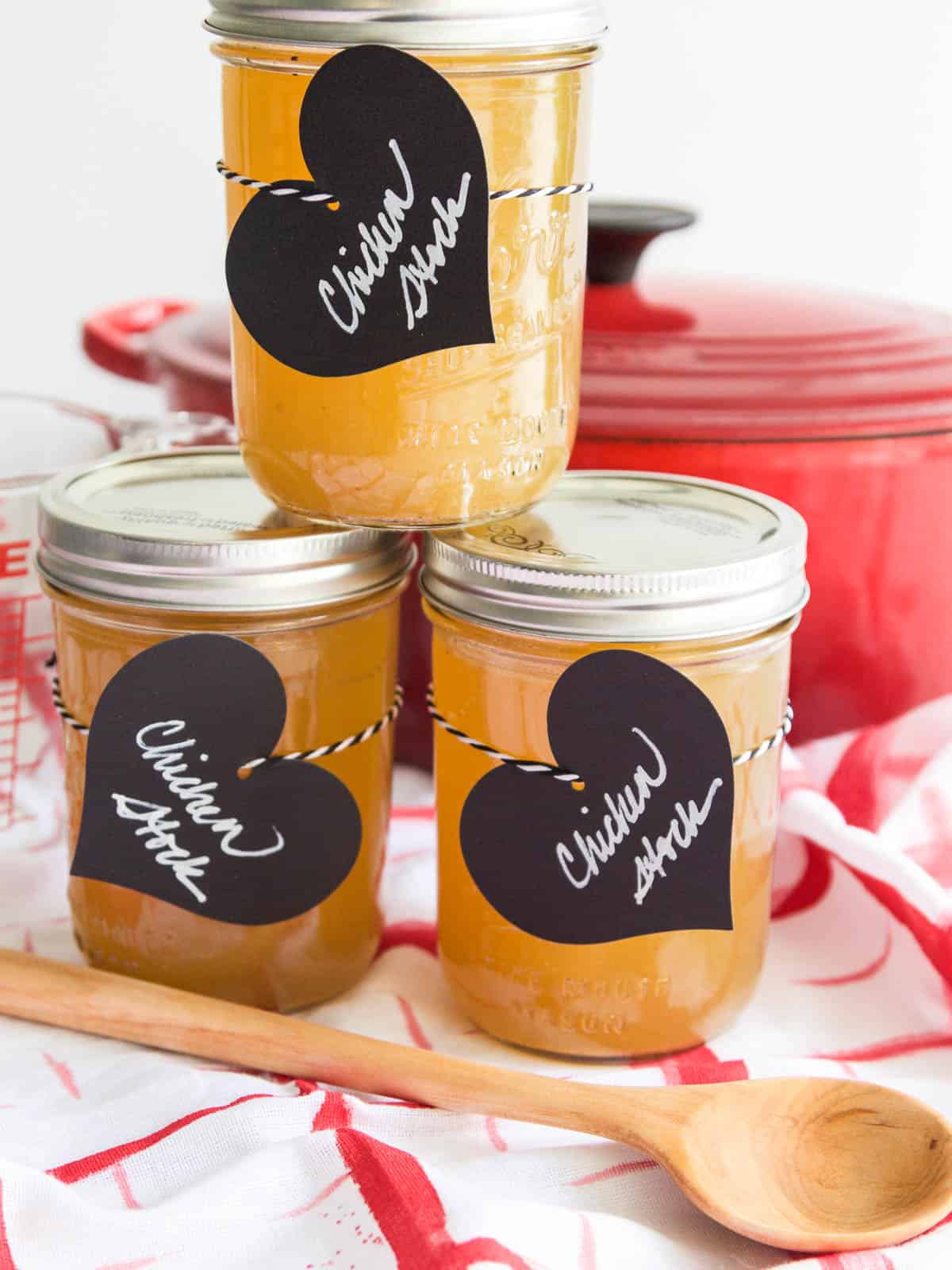

Table of Contents
- How to Make Chicken Stock
- Ingredients For Stock
- How To Make Chicken Stock
- Why This Recipe Really Works!
- How To Freeze Chicken Stock
- What containers can I freeze the chicken stock in?
- Chicken Stock vs. Broth vs. Boullion
- Top Stock And Bone Broth Tips
- Chicken Stock Bone Broth FAQ
- Chicken Stock (Bone Broth)Recipes
- More Chicken Stock Recipes
How to Make Chicken Stock
The simple ingredients for this recipe are so easy to keep on hand right in your freezer. Chicken bones or whole chicken carcasses, vegetables and their peels, herbs, seasoning, and water all go into the pot.
My Mom always made it this way with fresh ingredients, and it has a rich flavor and is wonderful compared to the store boxed version.
Ingredients For Stock
- 4 pounds frozen chicken bones (all parts; bones from chicken thighs, drumsticks, ribs, and breast bones all work!)
- 1 large peeled onion cut into 4 pieces
- 6 carrots peeled and cut in ½
- 6 ribs celery cut in ½
- 12 sprigs of fresh parsley with stems
- 3 bay leaves
- 1 teaspoon black peppercorns
- 1 small lemon sliced (try it, they add wonderful brightness!)
- 3 teaspoons sea salt
- 1-2 whole cloves peeled garlic (optional)
- other assorted herbs - thyme, sage, or rosemary are nice!
- cold water to fill over the ingredients
PRO TIP: The addition of salt makes a huge difference in the taste of stock/bone broth. You might be tempted to reduce the amount of salt, but it makes the flavor taste right. If you reduce it, you will a "muddy" flavor.
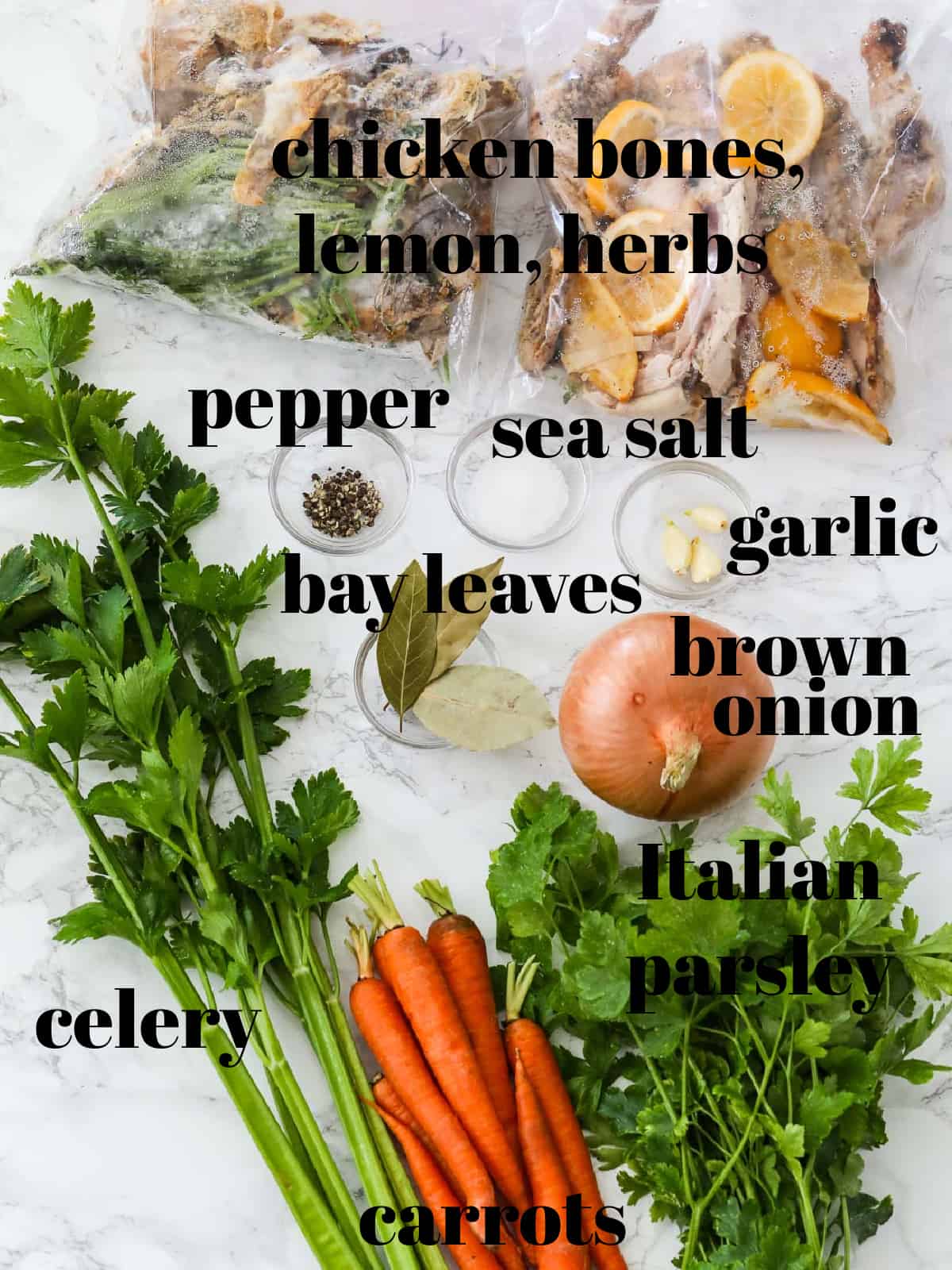

How To Make Chicken Stock
Gather Your Ingredients
Step 1: In a large pot or stockpot, place frozen chicken bones (no need for thawing!), vegetables, fresh herbs, and spices. I plan to make a lot of stock all at once from my freezer.
PRO TIP: Making stock is a great way to use up pieces of celery, onion, lemon, and carrot and clean out that fridge or freezer!
Start Your Stock
Step 2: Add additional water to just cover the top of the contents in the pot. Turn the heat on high and cook until you begin to see bubbles. Turn the heat down to a low simmer, you don't want it boiling. I like to add a nice handful of parsley on top. As the stock cooks, the ingredients will drop down into the pot and become fully submerged.
Simmering
Step 3: Simmer uncovered for 4-6 hours, on a low simmer. A simmer will create foamy bubbles on top, and you will see steam rising, and an occasional bubble will rise to the surface. It takes a while to cook, and your home will smell amazing. In the meantime, watch a movie, read a book, or take a nap!
Cooling Down Stock
Step 4: When done, turn the heat off. Carefully pull the large pieces out of the pot with tongs and discard them into the trash. I put the can right by the stove and will admit this is a laborious task, but it is the easiest way I have found. You will be rewarded with delicious results.
Strain & Storage
Step 5: Strain the stock through a colander or sieve into another large bowl or heatproof container and again discard any remaining bones and vegetables.
Now it is time to cool and freeze your stock.
PRO TIP: Be careful with the large container of hot liquid you cook in. You need to chill it down quickly and not let it just sit at room temperature. Carefully pour the hot stock into smaller bowls and chill with ice or in the fridge.
Why This Recipe Really Works!
- It's healthier than the boxed stuff because you control the ingredients, and use fresh veggies.
- This Chicken Stock recipe is just like bone broth you see in stores.
- If you use whole chickens to make stock results in a thick and rich due to the collagen in the bones. Sometimes I make it that way, but find this recipe is inexpensive as you don't need whole birds, and produces less waste. I just can't throw all that chicken meat away!
- You will notice the difference in your cooking when you use your own stock. And will love the flavor of soups, stews, and gravies!
- That "homemade chicken stock" smell fills your home and is the most pleasant aroma. Enough said!
- If someone isn't feeling so well, the first thing I do is break out stock and whip up a nice pot of chicken noodle soup or a cup of broth.
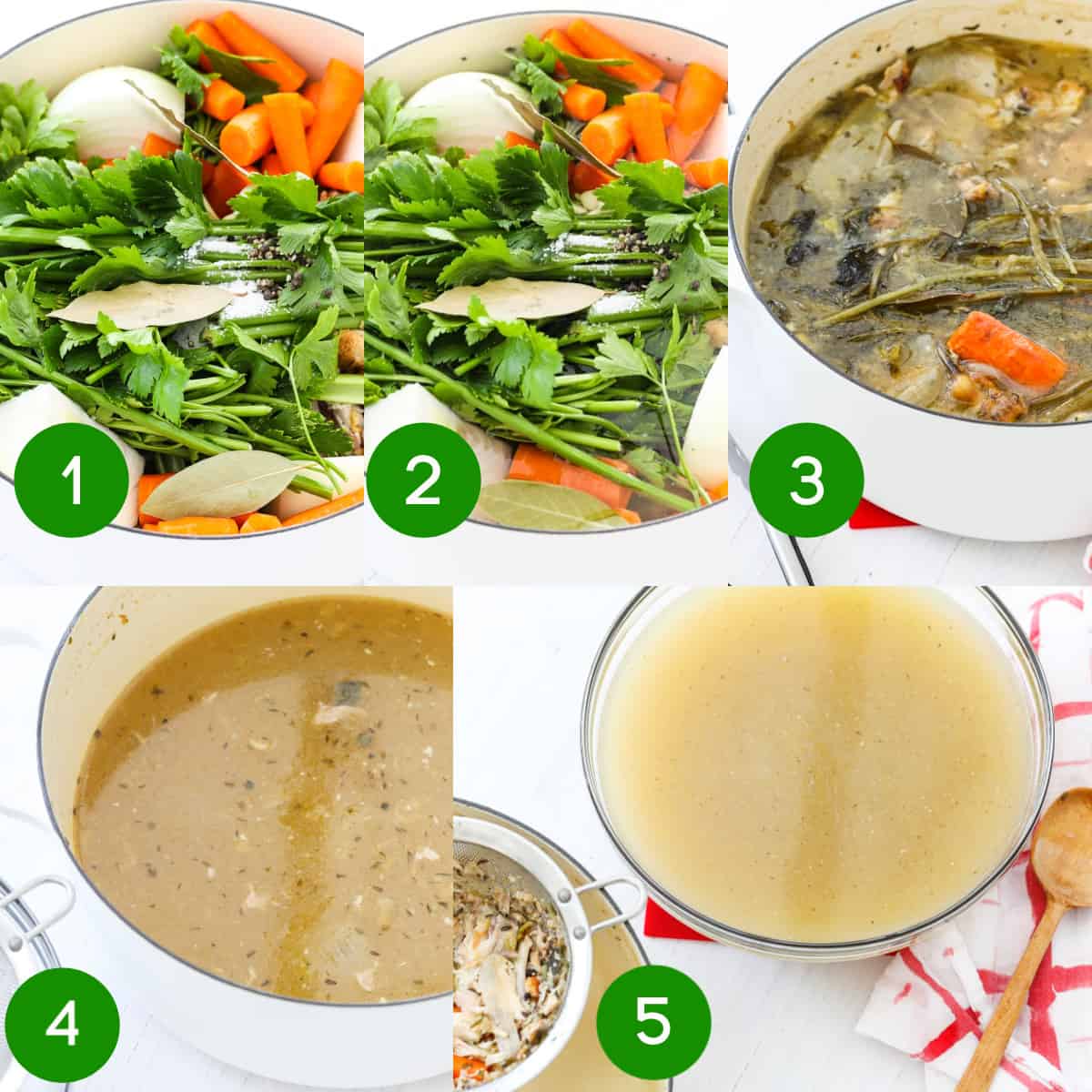
How To Freeze Chicken Stock
It is so easy to freeze stock, here is how you do it.
- Cool Stock: Pour your stock into bowls on the counter to cool, don't leave it on the counter for more than an hour. What I sometimes do is place ice packs (carefully) under the bowls to chill it down quickly so you can get it in the refrigerator/freezer quickly. Cool before storing it. You can add ice, and it will cool down quickly.
- Before freezing: Remove solidified fat from the surface of the top of the liquid.
- Ziplock bags: Take a ziplock bag, label it with the date, place it in a bowl or large glass measuring cup, turn the top edge of the bag down, fill using a measuring cup, then let the air out and zip closed. Lay on a cookie sheet to freeze and easily stack in the freezer.
- More ideas: Freeze in 1-cup measurements and pop into freezer bags. You can also freeze the stock in freezer-safe containers like Tupperware.
- Ice cube trays: Freeze in ice-cube trays, pop out, and put into dated/labeled freezer bags. Add cubes to make quick sauces and gravy.
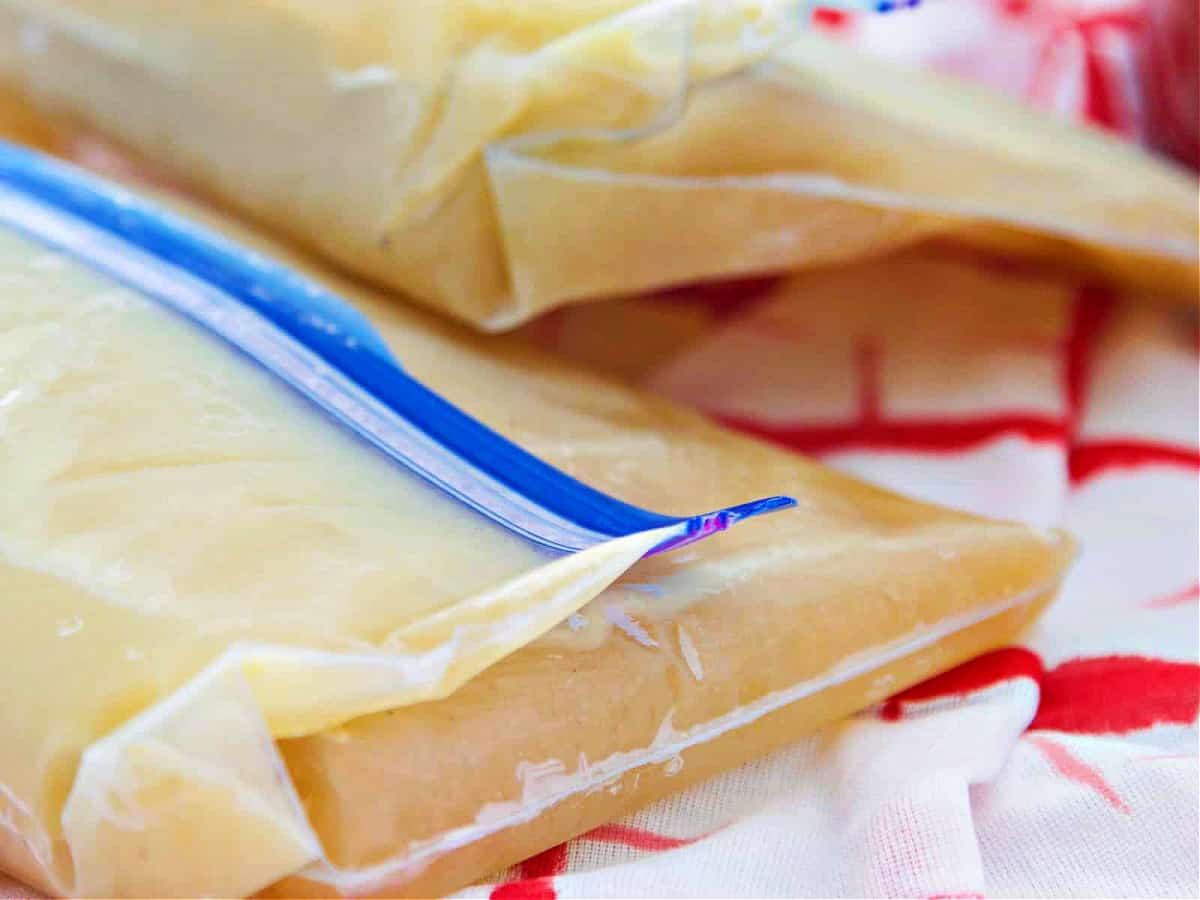
What containers can I freeze the chicken stock in?
There are different ways to freeze chicken bone broth or stock, here are some different storage method options and tips to choose the proper container.
You can use mason jars, covered glass airtight containers, a plastic container (just make sure it is BPA-free plastic), Ziploc bags, or heavy-duty freezer bags.
-freezer-safe container
-BPA-free plastic bags
-zip top quart bag or gallon bag
-canning jars
PRO TIP: You can freeze in a glass container like a mason jar, but it can crack and will need extra room in the jar for the stock to expand while it freezes.
A gallon-sized freezer bag works really well, simply label it first, fill it, and gradually lay on the counter to let the air out as you zip it closed.
For small leftover broth or 1 cup portions, freeze in muffin tins or make frozen cubes in ice cube trays. These can be tossed into sauces and avoid opening a large container.
PRO TIP: Pour chicken stock into bags, freeze flat on cookie sheets to store easier in the freezer! Freeze in ice cube trays, then pop into zip-top bags. Toss into sauce recipes, quick delicious soups, chicken dishes, rice, and many other uses.
How long does chicken stock last in the freezer?
Homemade Chicken Stock will store in the freezer for up to 6 months in freezer-safe air-tight containers or freezer bags.
For the best quality, use in 2-3 months. Also, try to remove as much air out of the container to avoid freezer burn.
How do I reheat frozen homemade chicken stock?
Take your frozen container from the freezer, it can take a long time to defrost in the refrigerator. Never bring to room temperature on the kitchen counter, it will not be food safe. Run the bottom of the container under hot water for a couple of minutes, remove the top, and let it release into a large pan. Add a cup of hot water, and turn the heat to melt the homemade chicken broth.
If stored in a Ziploc freezer bag, cut and peel off the zip-top bag, or run water over the container until the block releases. Place the frozen block in the pot, add a bit of water to the bottom of the pan, melt, and bring to boil for 2 minutes. Use as a base for dishes, soups, and sauces.
Chicken Stock vs. Broth vs. Boullion
While I was in cooking school, the first night we learned to make both chicken and beef stocks from professional chefs. In culinary terms, stocks are used frequently in the kitchen and elevate your cooking, think of them as a base ingredient just like salt and pepper.
But with all the terms chicken stock, bone broth, broth, and bouillion things got confusing! In class we were all asking so many questions, so let's talk about the slight differences...
PRO TIPS: Next to homemade stock, the store-bought is a great choice, and the Better Than Bouillion chicken base is terrific. You keep it refrigerated and simply mix it with water. There are chicken, beef and vegetable versions available in your grocery store.
Chicken Stock
Chicken Stock is made from primarily bones and vegetables just like this recipe. The traditional definition for a stock is more viscous due to the collagen that seeps out of joints and bones during long-term cooking.
You can make chicken stock using a whole chicken or just bones. I find that it is just fine with bones and thus little to no meat, skin, etc. However, some people prefer the thicker traditional style of stock and use whole chickens. I find that very expensive and wasteful.
Bone Broth
Bone Broth is thinner than stock and is made with more actual meat (versus just bones without meat) it is a new term on the culinary scene. I first heard it about 5 years ago, and said, "You mean chicken stock right?" And yes, that is what the person meant. I believe the term bone broth became popular with food manufacturers as a marketing term, as it became the trendy name on store packages.
The broth is a rarely used culinary term, it refers to making a thin soup from water that has been boiled with meat, fish, or vegetables.
Chicken Bouillon
Chicken Bouillon is a store-bought item and is concentrated in several forms. Small cubes, granules made by dehydration, or made into a chicken broth concentrate paste made from meat stock and natural juices. You might see it labeled as a chicken base.
Bouillon dissolves in plain water and is used to flavor other dishes, stocks, and soups. Also use it to flavor curries, gravy, stews, chili, and casseroles.
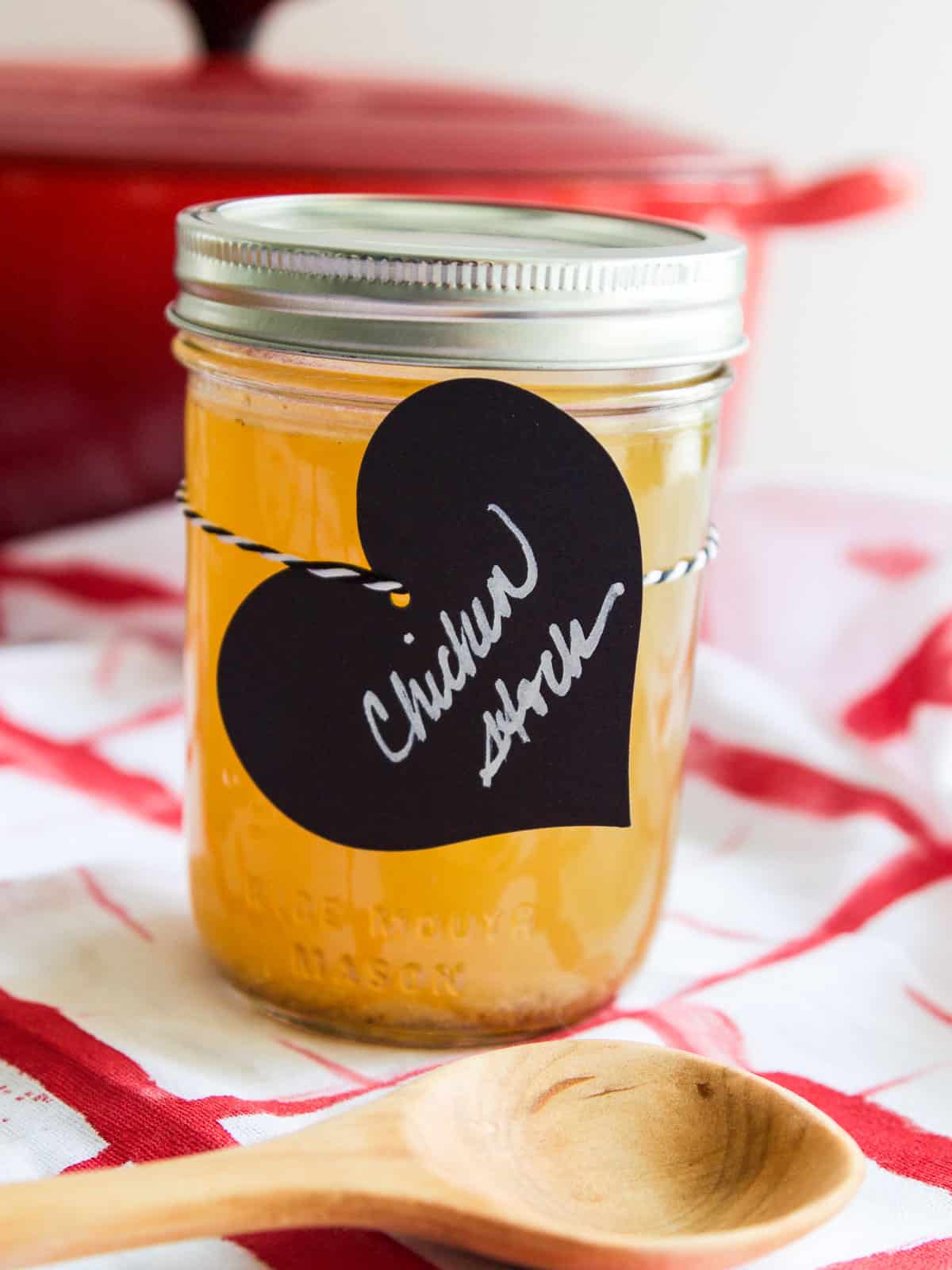
Top Stock And Bone Broth Tips
- Freeze the main ingredients: Keep your chicken bones and veggie scraps like parsley, celery and onions in bags in your freezer. Once the bag is full, I start a large pot on the stove or in the slow cooker on a cold lazy weekend day. Grab a few other things and you are on your way.
- Freeze bones from rotisserie chickens, wings, and even fried chicken. You can freeze right in the plastic box they come in from the grocery store or a ziplock bag. Collect bones from cooking; raw chicken pices, leftover bones, and any bony parts all work.
- Divide into frequently used portions (1 cup, 2 cups, or 1 quart) for easy usage. Label your containers or bags first, then measure into portions and fill your containers or zip lock bags.
- Lay filled ziptop bags on a cookie tray and freeze flat for easy storage.
- Take a spoon and do a taste test of your fresh batch of chicken stock before packing it up. You can adjust the salt a little bit if you need to.
- Toss lemons in, just squeeze in the juice and place the lemon halves right in your large pot. Trust me on this tip the lemons add a fresh brightness and extra flavor to your amber color stock...
Chicken Stock Bone Broth FAQ
According to the USDA, chicken broth or stock can be refrigerated safely for 3-4 days in a container. If you choose not to immediately use or freeze your Chicken Stock (Bone Broth), keep it in the coldest back part of your refrigerator under 40 degrees, and use it within 3 days to ensure the broth’s freshness.
Yes! Sometimes a little layer of chicken fat will form on the top of the broth once it is chilled or frozen. If you prefer, simply scrape it off with a spoon and you are ready to reheat.
Yes! And this is a good thing and a sure sign you have made an excellent Chicken Stock. What happened is that the collagen from the chicken bones causes the soup to gel. Well-cooked stock will have a rich depth of flavor.
In a pinch, add chicken bouillon in water. Another good substitute is to use vegetable stock you have on hand and add some shelf-stable bouillon. You can also use beef stock or beef broth. And red wine or white wine will work great! Note: These additions to a recipe will change the flavor profile of the dish.
Chicken Stock (Bone Broth)Recipes
The best thing is to have homemade for cooking at home. It isn't always possible, but these are my favorite ways to use flavorful stock in recipes...
- Chicken Noodle Soup
- Chili
- Rice ~ you will be amazed at the flavor rather than just using water!
- Risotto
- Alfredo Sauce
- Marinara Sauce
- Curry
- Gravy
- Stuffing
- Chicken Pot Pies
Oven-Baked Easy Parmesan Artichoke Risotto Risotto is a classic side dish made with arborio rice. This version cooks hands-free in the oven and has an amazing flavor!
Gorgonzola Leek Stuffed Chicken (One Pan) This one-pan dish is a hit for entertaining, special occasions, or a romantic date night dinner.
Tomato Soup with Basil Dumplings Hearty soups are so comforting in Winter. These easy fluffy basil dumplings soak up the tomato soup and make a filling dinner.
It doesn't get any more classic than Chicken Noodle Soup made with Homemade Chicken Stock. As a matter of fact, it makes all your soup recipes amazing!
More Chicken Stock Recipes
Make a perfect Turkey Gravy in just 10 minutes with this step-by-step guide and four simple ingredients.
This might just become your new Stuffing Recipe this holiday season. The texture is incredible, there is something different in each bite. Soft, crunchy, crispy, and chewy all in one happy stuffing.
A Turkey Dry Brine adds bold flavor to your whole Thanksgiving bird, and is easy to put together with a good spice blend right from your kitchen pantry. Skip those store-bought mixes. A perfect Roast Turkey has a great flavor that starts with the best seasoning.
A Spatchcock Turkey is also called a butterflied bird, roasts about 30 minutes faster than most recipes, has golden crispy skin, juicy meat, and carves like a dream!
CRAVING MORE?
Did you love this recipe? We would love to hear from you! If you make this recipe and love it, stop back, give it a 5-star rating ⭐⭐⭐⭐⭐ and leave a comment. THANK YOU!! Follow Delicious Table with my free newsletter and share this recipe with your friends on Facebook, Pinterest, and Instagram for more Delicious Table recipes!

Chicken Stock (Bone Broth) Plus Freezer Tips and 15+ Recipe Uses!
Ingredients
- 4 pounds frozen chicken bones use rotisserie chicken bones
- 1 large peeled onion cut in 4 pieces
- 6 carrots peeled and cut in ½
- 6 ribs celery cut in ½
- 12 sprigs fresh parsley with stems
- 3 bay leaves
- 1 teaspoon peppercorns
- 1 small lemon
- 3 teaspoons sea salt
- 3 whole cloves peeled garlic optional
- cold water to fill over ingredients
- other assorted fresh herbs: sage or thyme optional
Instructions
- In a large pot, Dutch oven, or stockpot, place chicken bones, vegetables, herbs and spices. I use bones previously frozen right from the freezer. Lemons add a wonderful brightness to chicken stock, just squeeze in the juice and place the lemon halves right in your stockpot.
- Add water to just cover the top of the contents in the pot and within an inch of the pot rim. Turn the heat to medium high heat and cook until you begin to see bubbles and some foam will appear on the top.
- Now, turn heat down to a low simmer, you don't want it boiling. Just some steam rising, some foam, and an occasional bubble. As it cooks, the ingredients will drop down into the pot and become fully submerged. About once an hour, you can push the ingredients under the surface to get all the flavor in there!
- Simmer on low for at least 4 hours, cool about an hour on the stove, then pull out the large solids carefully with a strainer and a large bowl. Discard the solids, they have done their job! Do one final straining with a finer sieve to pull the smaller pieces out and you have now made chicken stock.
- You can chill the stock quickly by adding ice to your stock. Once cooled, store in labeled freezer-safe ziplock or freezer containers. Be sure to get your stock chilled down and either in the freezer or fridge within an hour of cooking to keep it food safe.
Notes
Top Tips
- Freeze the main ingredients: Keep your chicken bones and veggie scraps like parsley, celery and onions in bags in your freezer. Once the bag is full, I start a large pot on the stove or in the slow cooker on a cold lazy weekend day. Grab a few other things and you are on your way.
- Freeze bones from rotisserie chickens, wings, and even fried chicken. You can freeze right in the plastic box they come in from the grocery store or a ziplock bag. Collect bones from cooking; raw chicken pices, leftover bones, and any bony parts all work.
- Divide the stock into frequently used portions (1 cup, 2 cups, or 1 quart) for easy usage. Label your containers or bags first, measure the stock into frequently used portions (1 cup, 2 cups, or 1 quart) and fill your containers or zip lock bags.
- Lay filled ziptop bags on a cookie tray and freeze flat for easy storage.
- Take a spoon and do a taste test of your fresh batch of chicken stock before packing it up. You can adjust the salt a little bit if you need to.
- Toss lemons in, just squeeze in the juice and place the lemon halves right in your large pot. Trust me on this tip the lemons add a fresh brightness and extra flavor to your amber color stock...
PRO TIP: Pour chicken stock into bags, freeze flat on cookie sheets to store easier in the freezer! Freeze in ice cube trays, then pop into zip-top bags. Toss into sauce recipes, quick delicious soups, chicken dishes, rice, and many other uses. These are great ways to use homemade chicken stock:
- Chicken Noodle Soup
- Chili
- Rice ~ you will be amazed at the flavor rather than just using water!
- Risotto
- Alfredo Sauce
- Marinara Sauce
- Curry
- Gravy
- Stuffing
- Chicken Pot Pies






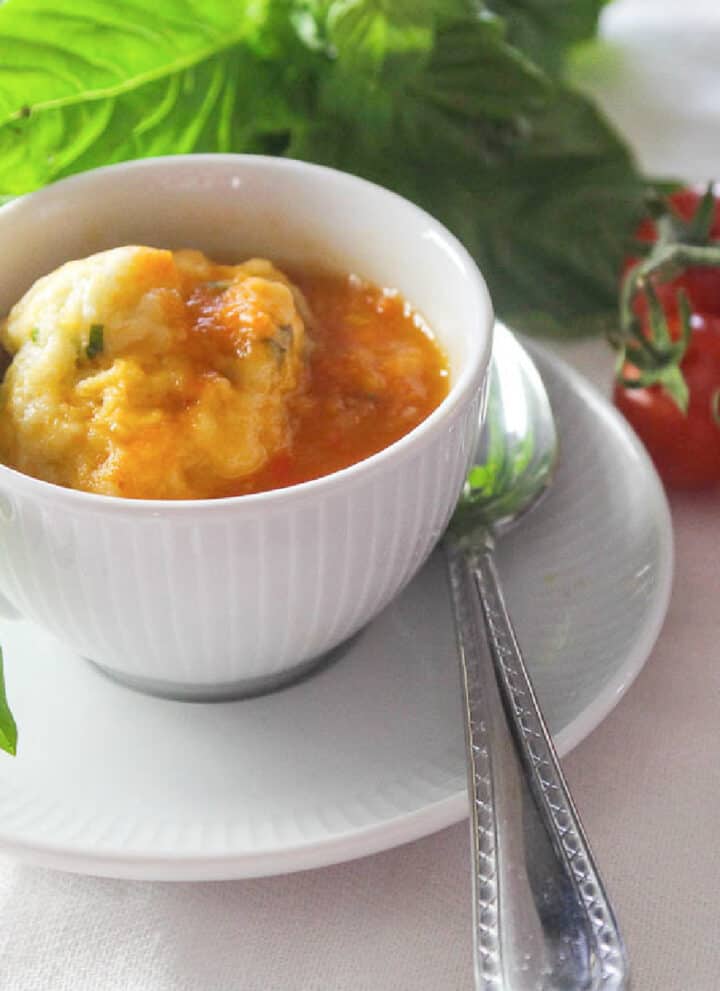
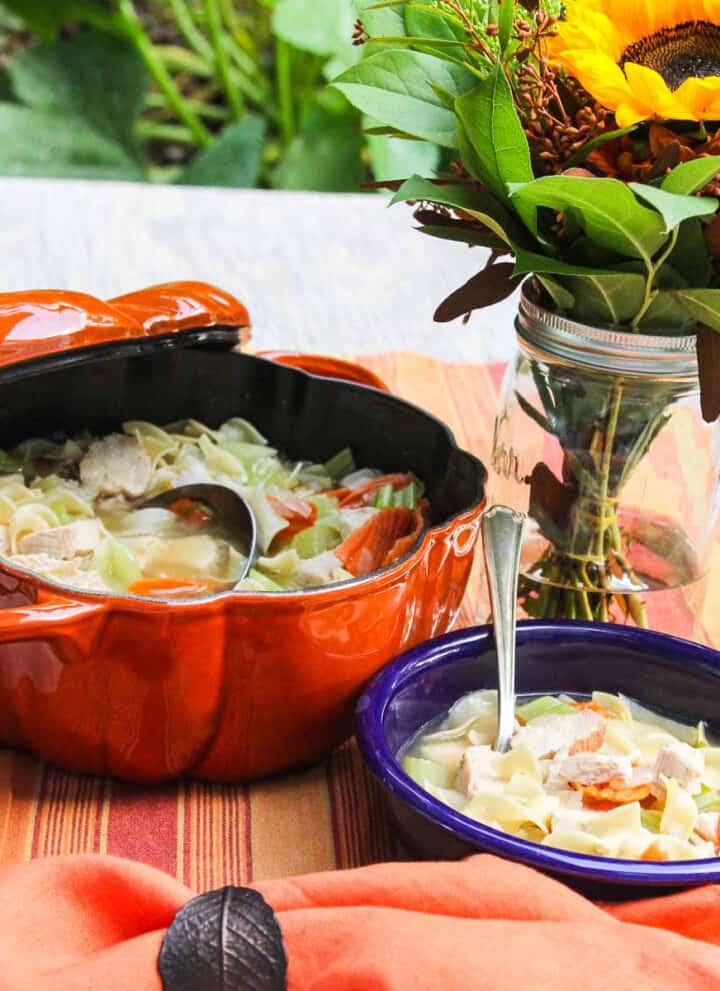










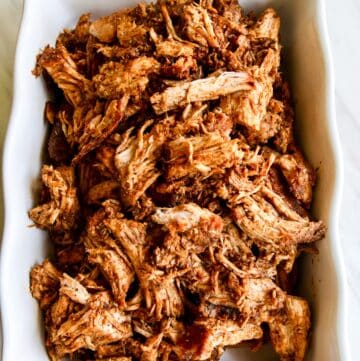




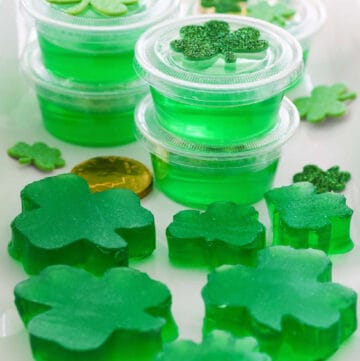

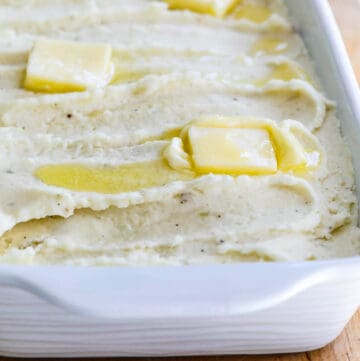
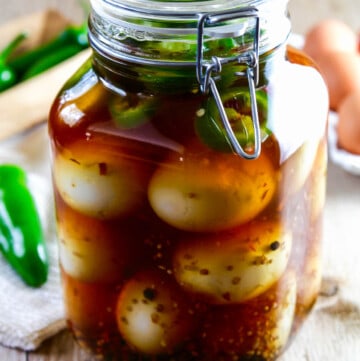

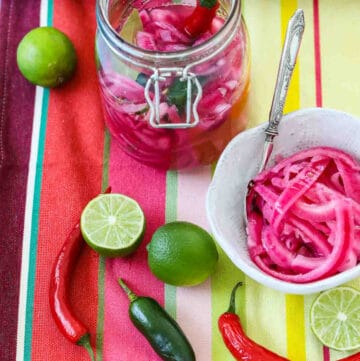

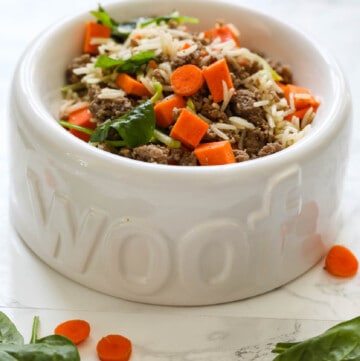





Oh no! I didn’t know it had to be stored within an hour… I left it out for 7! Please tell me it’s not bad????
Hi Amanda, oh no, sadly, it will not be food-safe sitting at room temperature that long. Chilling stock down fast and getting in in the fridge within two hours is a must. Then either use it in a recipe in 2 days or freeze it for later. Here is a site that is a great resource for food safety: https://www.foodsafety.gov/keep-food-safe/4-steps-to-food-safety
Keep food hot (140˚F or above) after cooking:
If you’re not serving food right after cooking, keep it out of the temperature danger zone (between 40°F -140°F) where germs grow rapidly by using a heat source like a chafing dish, warming tray, or slow cooker.
Leaving food on the counter puts it in the danger zone, don't worry just make some again!!! All the Best, Lisa
Thanks for this recipe. I love having bone broth for health reasons and hate buying store-bought stuff. This broth tasted so yummy. I'll definitely be keeping this recipe as a staple.
Wow! This made me have a total duh moment. I hate throwing away the rotisserie chicken bones and always feel like I should be getting more use out of the whole chicken. Making the stock is super smart and this tastes so much better (and less salty) than what I buy at the store. Less waste and more rich flavor, I'll take it! This is just a great staple recipe, very smart!